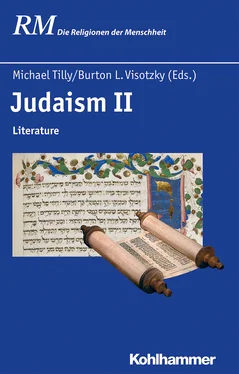Esau’s Kiss —Another example is the dots above the complete word וׄיׄשׄקׄהׄוׄ (»and he kissed him«) in Gen 33:4, which refers to Esau’s kissing of Jacob after the latter returns to Canaan. The rabbis suggest that the kiss was pretended or even that Esau tried to bite Jacob. The dots more likely indicate that the word should be erased, although the original reason for this erasure is unknown. The word could have been lacking in another manuscript to which the text was compared.
The so-called inverted nunim found in manuscripts and printed editions before and after Num 10:35–36, are actually misunderstood scribal signs for the removal of inappropriate segments, viz., the Greek letters antisigma [ Ͻ ] and sigma [ Ϲ ], known from Alexandria and the Qumran scrolls. The inverted nunim in this place indicated that these verses (the »Song of the Ark«) did not appear in their correct place. 21
These examples highlight the method of the MT scribes who believed everything in the text needed to be copied »as is.« Since these details were not meant to be copied into a subsequent text, the fact that the MT scribes did so is important evidence for understanding their approach.
2.4 Key Characteristics of the Masoretic Text
Sometimes it is difficult to define even the simplest things in life. All scriptural texts are compared to MT, but we do not usually ask ourselves what MT itself is. Here I will proceed to describe some of the key characteristics of MT in the area of spelling and other features of the text. We focus on the external features of the text as distinct from their content.
2.4.1 Consistency in Spelling
Above, we focused on aspects of the inconsistent spelling of MT. Here we note that despite these inconsistencies, the Masoretic corpus should be taken as constituting one organic unit because in a number of features, early and late books reflect the same practice in contrast to other texts, mainly those found at Qumran. Thus, it is remarkable that the following words are consistently spelled defectively in MT starting with the proto-MT scrolls and this same defective spelling is found in the proto-MT scrolls as well:
1. /o/ sounds in ,משה ,כל ,מאד 22אלהים ,כהן ,כח
2. /o/ sounds in the same word pattern: 23בקר חדש ,אהל,קדש
3. the archaic form of the name of Jerusalem as ירושלם 24
4. /u/ sound in נאם
Likewise, it is remarkable that the following words are always spelled with full spelling (plene):
1. נביא in the singular.
2. The word מדוע. 25
3. The pattern qatol (vowels a‒o), e.g., ,כבוד ,טהור 26שלום. 27
4. The full spelling of the name פינחס is notable. 28
These spelling practices most likely were developed first for the writing of the Torah, and were adopted from there to the writing of the later books.
The internal diversity in MT described above should not surprise us, since the other collections of the Hebrew and translated Bible, such as the LXX, Peshitta (the Syriac Bible translation) and the Targumim (the Aramaic Bible translations), also are not unified. This lack of unity of the scriptural corpora was created by the combination of a large number of diverse scrolls in the archetype of each corpus. MT was no exception, showing internal diversity in the following practices:
1. Section divisions—named in MT »open section« ( parashah petuhah ), a space at the end of a line, and »closed section« ( parashah setumah ), a space in the middle of a line—occur frequently in all the Judean Desert fragments, non-biblical and biblical, the latter of Masoretic and non-Masoretic content.
There is no rule regarding the length of a section demarcated by preceding and following section breaks; that depended much on the scribe’s understanding. The two extremes of frequent and infrequent section divisions can be seen in the Qumran scrolls as well as in MT. While most books in MT average one section unit per 7–10 verses, some books stand out having a substantially lower or higher percentage, when compared with other units in the same literary genre: 29
Some books of Scripture stand out as having many more or many fewer divisions than other books in the same literary genre. Since the different paragraphing systems go back to the personalities of the scribes, the scribes of the MT books must have differed among themselves.
2. Dotted letters . In fifteen places, all the medieval manuscripts of MT denote dots above certain letters and words, and in one place (Ps 27:13) also below them. Ten of these instances are found in the Torah, four in the Prophets, and one in the Writings. Thus, the Torah contains significantly more scribal dots above letters than the other books. The background of this unusual distribution is unclear. Possibly the custom of canceling letters was essentially discontinued in the later Scripture books.
3. »A section division in the middle of a verse« ( pisqa be-emtsa pasuq ) (henceforth pbp ). As a general rule, the section divisions in MT coincide with the ends of verses. Nevertheless, MT has 28 instances of pbp noted. 30The indication of a pbp signifies a break in content similar to that indicated at the end of a section.
The occurrences of pbp are unevenly distributed in the Bible, since 65 percent of them (following the Aleppo codex) occur in one book, viz., Samuel. 31The high frequency of this phenomenon in Samuel probably implies that the textual tradition of this book was less stable than that of the other books, as do many of its differences from the LXX and the Qumran scrolls.
4. Spelling . The distribution of full and defective orthography shows some peculiarities of the individual books. The Torah and the book of Kings in MT reflect the most conservative (defective) orthography and also contain the greatest degree of internal consistency. 32In the Torah, this description applies especially to Exodus and Leviticus, in particular the Book of the Covenant (Exodus 21–23). 33
Among the Minor Prophets, Amos is the most defective, and Jonah is the fullest spelling. 34The books with the fullest orthography in MT are Qohelet, Song of Songs, and Esther, followed by Ezra–Nehemiah and Chronicles.
5. Orthographic features of the Torah. Four archaic spellings and forms characterize the Torah as a whole:
a) The Ketiv 35הוא. The majority spelling (ketiv) of the third person single feminine pronoun in the Torah is accompanied by a Qere הִוא (pronounced hee). 36This possibly represents an early dialectal form in which the masculine and feminine forms (both: huʾ) were not distinguished. 37This form occurs mainly in the Torah.
b) The Ketiv: na‛arā . The unusual Ketiv נער accompanied by a Qere נַעֲרָ occurs twenty-two times in the Torah, as opposed to a single occurrence of נערה in Deut 22:19 (also occurring elsewhere in MT).
c) The archaic pronominal suffix הֹ- (instead of with a vav) of the type of אהלֹה is much more frequent in the Torah (»his tent,« e.g., Gen 9:21) than in the later books. The fourteen instances in the Torah should be compared with thirty-seven in the remainder of the books. 38In addition, the unique spelling כֻּלּה also occurs eighteen times outside the Torah. 39
d) The demonstrative pronoun הָאֵל for האלה occurs only in the Torah (8x), 40including three times in the phrase הערים האל (Gen 19:25; Deut 4:42; 19:11) and twice in הארצת האל (Gen 26:3, 4).
6. Mistakes in MT . Scribes err all the time, but when a book contains a high number of mistakes, this feature is to be considered as part of the scribal character of the book, 41as in the frequent scribal errors in the MT of 1–2 Samuel, as compared with the LXX and 4QSam a. 42Such mistakes are rare in the Torah.
Читать дальше







